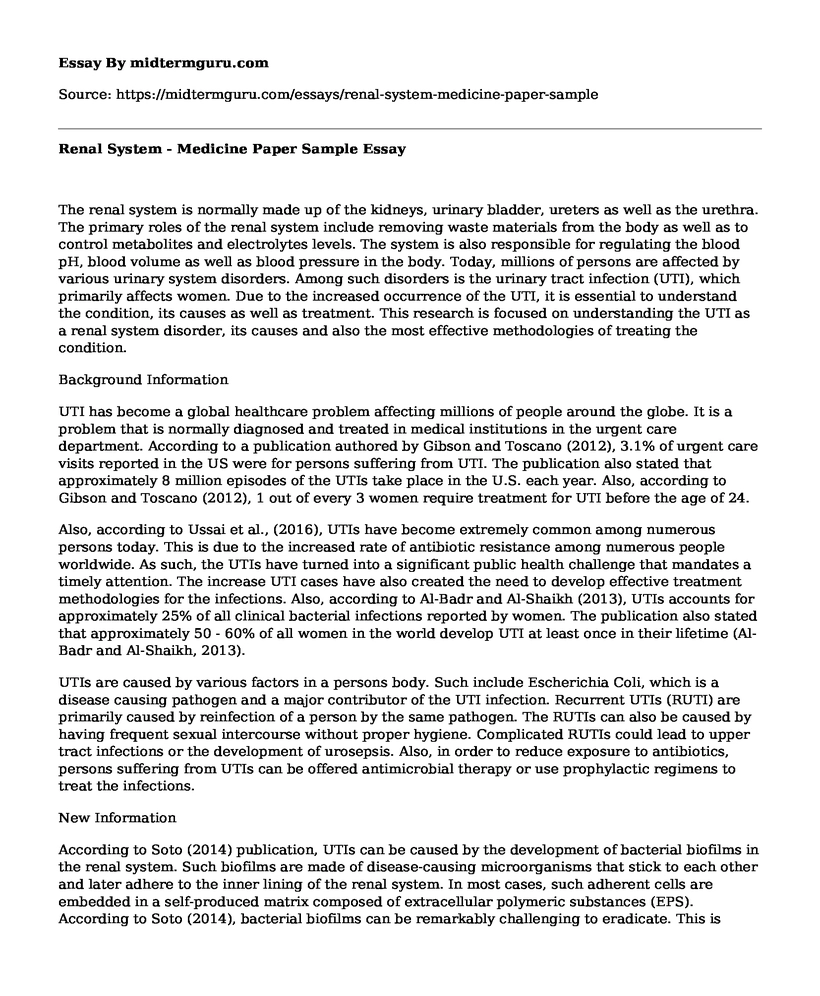The renal system is normally made up of the kidneys, urinary bladder, ureters as well as the urethra. The primary roles of the renal system include removing waste materials from the body as well as to control metabolites and electrolytes levels. The system is also responsible for regulating the blood pH, blood volume as well as blood pressure in the body. Today, millions of persons are affected by various urinary system disorders. Among such disorders is the urinary tract infection (UTI), which primarily affects women. Due to the increased occurrence of the UTI, it is essential to understand the condition, its causes as well as treatment. This research is focused on understanding the UTI as a renal system disorder, its causes and also the most effective methodologies of treating the condition.
Background Information
UTI has become a global healthcare problem affecting millions of people around the globe. It is a problem that is normally diagnosed and treated in medical institutions in the urgent care department. According to a publication authored by Gibson and Toscano (2012), 3.1% of urgent care visits reported in the US were for persons suffering from UTI. The publication also stated that approximately 8 million episodes of the UTIs take place in the U.S. each year. Also, according to Gibson and Toscano (2012), 1 out of every 3 women require treatment for UTI before the age of 24.
Also, according to Ussai et al., (2016), UTIs have become extremely common among numerous persons today. This is due to the increased rate of antibiotic resistance among numerous people worldwide. As such, the UTIs have turned into a significant public health challenge that mandates a timely attention. The increase UTI cases have also created the need to develop effective treatment methodologies for the infections. Also, according to Al-Badr and Al-Shaikh (2013), UTIs accounts for approximately 25% of all clinical bacterial infections reported by women. The publication also stated that approximately 50 - 60% of all women in the world develop UTI at least once in their lifetime (Al-Badr and Al-Shaikh, 2013).
UTIs are caused by various factors in a persons body. Such include Escherichia Coli, which is a disease causing pathogen and a major contributor of the UTI infection. Recurrent UTIs (RUTI) are primarily caused by reinfection of a person by the same pathogen. The RUTIs can also be caused by having frequent sexual intercourse without proper hygiene. Complicated RUTIs could lead to upper tract infections or the development of urosepsis. Also, in order to reduce exposure to antibiotics, persons suffering from UTIs can be offered antimicrobial therapy or use prophylactic regimens to treat the infections.
New Information
According to Soto (2014) publication, UTIs can be caused by the development of bacterial biofilms in the renal system. Such biofilms are made of disease-causing microorganisms that stick to each other and later adhere to the inner lining of the renal system. In most cases, such adherent cells are embedded in a self-produced matrix composed of extracellular polymeric substances (EPS). According to Soto (2014), bacterial biofilms can be remarkably challenging to eradicate. This is because of their antimicrobial resistant phenotype. Nevertheless, patients suffering from UTIs due to bacterial biofilms development in their renal systems can be treated by using combined UTI therapy treatments.
Conclusion
In conclusion, the renal system is made up of the kidneys, urinary bladder, ureters as well as the urethra. Its primary function is to remove the waste materials from the body as well as to regulate metabolites and electrolytes levels. The UTI is a major infection that normally affects the renal system. It is caused by bacterial infection and mostly affects women. From the research, it is evident that UTI infection rate has increased due to antibiotic resistance among numerous people worldwide. The UTIs have also increased due to the formation of bacterial biofilms in the renal system. Ultimately, it is essential for the health care sector to develop more effective strategies focused on reducing the high UTI rates in the world.
References
Al-Badr, A., & Al-Shaikh, G. (2013). Recurrent Urinary Tract Infections Management in Women: A review. Sultan Qaboos University Medical Journal, 13(3), 359367.
BIBLIOGRAPHY Gibson, K., & Tascano, J. (2012). Urinary Tract Infection Update. American Journal of Clinical Medicine, 9(2), 82-86.
Soto, S. M. (2014). Importance of Biofilms in Urinary Tract Infections: New Therapeutic Approaches. Advances in Biology, 1-13. Retrieved from http://dx.doi.org/10.1155/2014/543974
Ussai, S., Rizzo, M., Liguori, G., Umari, P., Pavan, N., Cai, T., . . . Trombetta, C. (2016). Antibiotic Treatment of Urinary Tract Infections (UTIs) In Primary Care: An Italian Pilot Study. Journal of Pharmacovigilance, 4(4). doi:10.4172/2329-6887.1000215
Cite this page
Renal System - Medicine Paper Sample. (2021, Jun 04). Retrieved from https://midtermguru.com/essays/renal-system-medicine-paper-sample
If you are the original author of this essay and no longer wish to have it published on the midtermguru.com website, please click below to request its removal:
- Essay on Predicting Hospital Readmission Risk
- Evaluation Essay on Bill Wilson Center
- Essay Sample on Life in Wheels: Stephany's Story
- Rising Prescription Drug Prices: A Major Issue and Call for Action - Essay Sample
- Diversity in Healthcare Personnel: Key to Success - Essay Sample
- Social Work: Assisting Individuals to Improve Wellbeing - Essay Sample
- Family Health Care Nursing: A Comprehensive Overview - Essay Sample







